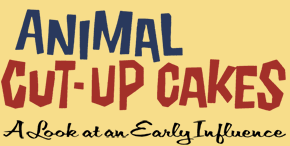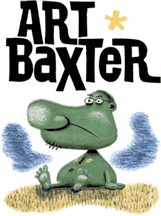

"I tend to think that nothing after the age of nine informs you as an artist."
-Daniel Clowes - The Comics Journal #233 - May 2001
Many artists, specifically cartoonists, seem to recreate, in their life's work, something that was branded upon their tender brain at a young impressionable age. As a child, was baptized in the mass culture and trash culture of the 1960. A list of my favorite things of that era would include: Little Golden Books; Rocky & Bullwinkle and The Flintstones; 1930s Universal monster movies (specifically Frankenstein); TV shows like Captain Kangaroo, Mr. Ed, The Addams Family, The Munsters, Lost in Space, the whole mid 60s Batman craze; DC, Marvel and Gold Key comics; early Japanese anime like 8th Man and Speed Racer and the live action Ultraman; Charles Schulz's Peanuts including the newspaper strip, paperback books, TV specials and everything else; The Monkees; Wacky Packages, Odd Rods and other bubble gum cards; cheap rubber monsters; bendable Gumby toys; Matchbox cars and Hot Wheels; Lincoln Logs and Lego blocks; I could go on and on.
One small artifact that attracted my attention was a modest promotional booklet put out by the General Foods Corporation for their Baker's 'Angel Flake' Coconut in 1959. It was a free booklet on how to make animal cakes out of standard boxed cake mixes, icing and Baker's Coconut: the ANIMAL CUT-UP CAKES. The object of General Foods, of course, was to sell more flaked coconut. My mother kept the booklet in a folder, in a drawer with her other recipes. Every so often to booklet would come out of the drawer with the other recipes. If I saw it I would want to look at it. Sometimes , I think, I would want to see the booklet if I had thought about it for some reason or another. Of course, I would ask to see it and not just take it for myself.
Every so often I would look at the booklet through the years from preschool to high school. Sometimes with several years passing between viewings. I think the appeal of the booklet was at first interest in how the booklet looked and then later, a mixture of that and nostalgia. It is interesting to note that I don't remember my mother actually making any of the cake designs in the book. She made a lamb cake with the white coconut, using jelly beans for eyes and a nose, for Easter a few times in the mid 60s, but that's as close as she got. She may have made a cake based on the designs in the booklet before the memory of my life started, but alas, I just don't remember.
I went to art school in the early 80s and as I learned about design, typography and illustration I remembered the booklet and once again sought it out. This time I looked at the book as an artifact from another period of graphic design history with it's funky type and odd and intriguing color palate. Even the cakes themselves were nicely designed with bold simple forms and an unfussy economy of detail. At this point in time, the booklet was simply old fashioned and hadn't yet picked up an patina. This was the era when Milton Glaser, Seymour Chwast and their PUSHPIN Studio was the dominant design aesthetic. An aesthetic I never quite took a cotton to. That old late 50s modern was déclassé and the term "Retro" wouldn't be coined for a few years yet.
At some point in the late 80s or early 90s I asked my mother If I could have the booklet for my collection of type and illustration specimens. Since she thought she would probably never want to bake a cake like that, she gave me the damn thing.
Perhaps now I should speak of the booklet itself. It's a 4-color 36 page saddle-sticthed booklet measuring 4.75" x 6.25". The book opens with a spread proclaiming the greatness of Bakers Coconut. It also mentions the cakes were created in the General Foods kitchens. There is no copyright notice but it was printed in the USA in 1959 by General Foods. What follows are 15 spreads presenting 16 cakes (the final cake spread are a boy and girl pair). There are simple instructions and two small photos on how to construct the cakes. There is a large photo of the finished product. The final spread gives tips on: cutting and frosting the cakes, tinting the coconut with food coloring, toasting the coconut and 'fluffy-type' frosting recipes. The back cover shows that Baker's Coconut is available in a can or box and we are given the address of the General Foods Corporation in White Plains, New York.
The funky type used throughout the booklet is a freeform script probably drawn with a steel inking brush which would account for the sharp edges and varying line widths. When I scanned the booklet I created a specimen sheet of this typeface. Although the letter forms are similar, no two are the same. The type is a script rather than a font.
The color photos have an odd appearance unlike standard photography. They resemble hand tinted black and white photos. I don't think they are. I believe they are simply the result of the type of lithography the printer used. I like the color palate of this booklet. It gives the booklet that period feel. In addition to the typeface specimen sheet I also synthesized a color palate. I used that palate for the colors on this website. I also used the typeface a few places. These elements give the site the 'retro' feel I was looking for.
One could look at the ANIMAL CUT-UP CAKES booklet, as this website's artistic ancestor.








To view:
Either click
on the cover
to see the booklet
in sequence
or click images below to see separate pages.













The ANIMAL CUT UP CAKES booklet is believed to be in the public domain • The posting of this booklet is for scholarly and educational purposes.
Commentary & Design © 2014 Art Baxter • All Rights Reserved
Commentary & Design © 2014 Art Baxter • All Rights Reserved